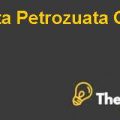The Valuation & Financing of Lady M Confections: Case Study Help
Introduction
In the month of May 2001, Lady M Confection was established. It is a confectionery company that specializes in supplying consumers with delectable cakes and confectionaries. By entering the wholesale market for cakes and pastries to large and elegant hotels, restaurants, and merchants in New York City, it has developed a name and a prominent brand image for itself. In this report, the company's financial analysis will be completed, including financial ratio analysis, and common size analysis. The research will help determine the company's financial and operational strength, allowing it to expand and prosper in the future.
Case Analysis
This case examines the decision-making process in which small and private organizations must go through when considering expansion or selling shares to outside investors. Students are required to perform two exercises as part of the process, first is a break-even analysis and second is a valuation exercise.
1) Financial Ratio Analysis
A company's financial statements are used to calculate financial ratios, in which they study a company's Balance Sheet and Income Statement to determine its profitability, liquidity, and bankability. Evaluating those ratios helps for a better realization of a company's financial status, and they are frequently requested by banks, investors, and management in order to better comprehend financial statements. Another application is when comparing two firms' financial analysis, such as profitability indicators like Return on Capital Employed (ROCE) or EBITDA Margins. The financial ratio analysis are as under:
Current & Quick Ratio
The current ratio is used to calculate the difference between current assets and current liabilities. A current ratio of greater than 1 indicates that the company's current assets exceed its current liabilities, which is a positive sign and indicates that the company is liquid, whereas the quick ratio of the company also provides the same information about the company's liquidity, but the quick ratio determines a clear image by subtracting the less liquid items from the current assets, such as investment. In the year 2012, the company's current ratio and quick ratio are 1.39 and 1.33, respectively. In the year 2013, both the current and quick ratios decreased to 1.79 and 1.66 respectively. As a result, the current and quick ratios are decrease, indicating that the company's liquidity is not improving, which is a negative indicator.
Inventory Turnover Ratio:
Inventory turnover ratios are used to measure how well a company's management converts its inventory into sales, i.e. changing raw materials into finished goods and selling them to customers. As a result, the company's inventory turnover ratio has decrease from 56 to 6, indicating that it has reduced revenue by selling inventory to the eventual users of the commodities made. Because revenue generation has dropped in comparison to inventory produced by the company from 2012 to 2013, a low inventory turnover ratio is a negative sign for the business.
Day Sales Outstanding:
Day sales outstanding ratios reveal how well a company manages its receivables, i.e. how well it collects receivables, and how liquid it is in terms of liquidity management through accounts receivable. As a result, the firm's day sales outstanding ratio has risen from 2012 to 2013, indicating that the company has not reduced the number of days it takes to collect receivables, implying that it is not collecting accounts receivable efficiently in contrast to previous years.
Average Sales per Day:
The average sales per day declined from 2012 to 2013, indicating that the company did not able to increase revenues from the previous year, which is a negative sign because the company's sales are not expanding.
Fixed Assets Turnover:
The company's fixed asset turnover shows how it uses fixed assets to create revenue. Although the company's revenues have increased in recent years, its fixed asset turnover has decreased, falling from 9.19 to 0.32 in contrast to the prior year. As a result, the decrease in fixed asset turnover ratios indicates that the company has increased its investment in fixed assets, resulting in lower fixed asset turnover ratios.
Total Assets Turnover
Ratio
The total asset turnover ratio shows how a company's total assets are being used to generate income. As a result, the company's total assets turnover ratio decreased from 2012 to 2013, falling from 2.96 to 0.17, indicating that the company's total assets have increased in comparison to its revenues, which has increased from the previous year.
Debt Ratio
Dividing total liabilities by total assets, the company's debt ratio can be computed. The debt ratio shows how much debt a company has accrued in relation to its assets. The company's debt ratio has decreased from 0.70 to 0.58, which is a positive sign because its debt has decreased over the previous year when compared to its assets.....5
The Valuation & Financing of Lady M Confections Case Study Help
order on the website to order your own originally done case solution."}" data-sheets-userformat="{"2":14913,"3":{"1":0},"9":0,"12":0,"14":{"1":2,"2":3355443},"15":"\"open sans\", Arial, sans-serif","16":10}">This is just a sample partial case solution. Please place the order on the website to order your own originally done case solution.













